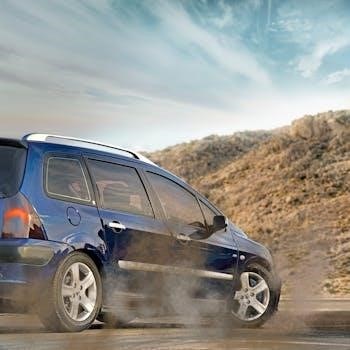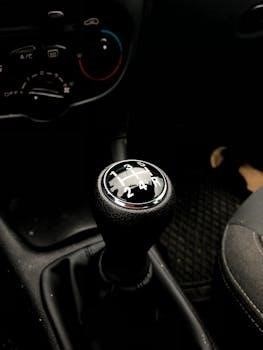Overview of the HM290 Manual Transmission
The HM290, designed by Getrag and produced by GM, is a 5-speed manual transmission found in GM and Dodge light trucks. It is known for its reliability and smooth shifting. It has a torque capacity of approximately 300 ft-lbs.
HM290 Applications and Vehicle Models
The HM290 manual transmission saw extensive use in a variety of General Motors (GM) and some Dodge vehicles, primarily during the late 1980s and throughout the 1990s. Specifically, it was a common choice for light-duty trucks and vans, offering a robust and reliable option for drivers.
GM’s C/K series trucks, including the popular 1500 and 2500 models, frequently featured the HM290. Additionally, the S-10 pickup and its sibling, the S-15, also utilized this transmission, starting from the 1990 model year. Vans like the G-series (e.g., G1500, G2500) were another common application, providing a durable solution for hauling and utility purposes.
While primarily associated with GM, some Dodge vehicles also incorporated the HM290. The transmission’s adaptability and torque handling capabilities made it a suitable choice for a range of light to medium-duty applications across different makes and models.
NV3500 vs HM290⁚ Key Differences
Although visually similar, the NV3500 boasts a higher torque capacity than the HM290. Internally, the HM290 uses a 3-shift rail design, while the NV3500 utilizes a simpler, more robust single-rail system.
Shift Rail Design and Internal Components
The HM290 distinguishes itself with a more intricate shift rail design. It employs a 3-shift rail system, contrasting with the NV3500’s single-rail mechanism. This difference in design impacts the transmission’s overall feel and potential points of failure. The HM290’s internal components, including bearings and synchronizers, differ from those found in the NV3500.
Specifically, the HM290 features a more complex arrangement of internal components due to its shift rail design. This complexity, while contributing to a certain shift feel, also makes the HM290 potentially more prone to issues compared to the NV3500’s simpler setup. Understanding these internal differences is crucial for proper maintenance and repair.
While both transmissions share a similar external appearance, their internal architectures diverge significantly. The HM290’s shift rail system and unique component specifications highlight its distinct design and operational characteristics. These differences are critical to consider when diagnosing problems or considering a transmission swap.
Torque Capacity and Durability
The HM290, while a robust transmission, generally has a lower torque capacity compared to the NV3500. The HM290 is rated for approximately 300 ft-lbs of torque. This makes it suitable for light-duty applications.
In terms of durability, the HM290 is considered reliable for its intended applications. However, when pushed beyond its torque capacity, it can be more susceptible to failure compared to the NV3500. The NV3500 is designed to handle more powerful engines.
Therefore, when considering the HM290, it’s crucial to assess whether its torque capacity aligns with the engine’s output and intended usage. For higher-performance applications or those involving heavier loads, the NV3500 is generally the preferred choice due to its superior torque handling and enhanced durability.
Proper maintenance can extend the lifespan of the HM290. However, its inherent torque limitations should be carefully considered.

HM290 Specifications
The HM290 features a 5-speed design with specific gear ratios optimized for light to medium-duty trucks. It has a torque capacity of 300 ft-lbs and a GVW rating of 7,000 lbs maximum for trucks.
Gear Ratios
Understanding the gear ratios of the HM290 is crucial for assessing its performance characteristics. The HM290 features specific ratios designed to optimize both acceleration and fuel efficiency in light to medium-duty applications. These ratios determine the relationship between engine speed and wheel speed in each gear.
First gear typically offers a high ratio, providing ample torque for initial acceleration and towing. Subsequent gears progressively decrease in ratio, allowing for efficient cruising at higher speeds. The HM290 gear ratios are 4.016⁚1 for first gear, 2.323⁚1 for second gear, 1.401⁚1 for third gear, 1.00⁚1 for fourth gear, and 0.729⁚1 for fifth gear, offering a balance between power and economy.
These ratios, in conjunction with the engine’s power band and the vehicle’s overall weight, influence the HM290’s ability to handle various driving conditions. It should be noted that the ratios play a vital role in the overall driving experience.
Torque and GVW Ratings
The HM290’s torque and GVW (Gross Vehicle Weight) ratings are important considerations when evaluating its suitability for different applications. The HM290 is designed to handle a specific amount of torque produced by the engine, ensuring reliable operation and preventing premature failure. Exceeding the rated torque can lead to damage to the transmission’s internal components.
The HM290 is designed to handle approximately 300 ft-lbs of torque. This makes it a suitable option for light-duty trucks. The GVW rating indicates the maximum weight the vehicle can safely handle, including the vehicle itself, passengers, and cargo. The HM290 has a GVW rating of 7,000 lbs.
Operating within these limits ensures the longevity and durability of the HM290 transmission. It should be noted that exceeding the torque and GVW ratings can lead to premature wear and potential failure of the transmission.
Common Problems and Troubleshooting
Like any mechanical component, the HM290 manual transmission can experience problems over time. Identifying these issues early and performing proper troubleshooting can save time and money on repairs. Common problems include difficulty shifting, unusual noises, and fluid leaks. Difficulty shifting can stem from worn synchronizers, damaged shift forks, or low fluid levels;
Unusual noises, such as whining or grinding, may indicate worn bearings, damaged gears, or insufficient lubrication. Fluid leaks can occur from seals, gaskets, or the transmission case itself. Regular inspection of fluid levels and condition is crucial for preventing these problems.
Troubleshooting often involves checking the fluid level, inspecting for leaks, and listening for unusual noises. Addressing these issues promptly can extend the life of the HM290 transmission.
Rebuilding and Remanufacturing the HM290
Rebuilding the HM290 involves a detailed inspection, parts replacement, and rigorous testing to meet OEM specifications. Remanufactured units offer a cost-effective solution, ensuring renewed performance and durability, backed by quality standards and inspection processes.
Inspection Process and Quality Standards
The rebuilding of HM290 transmissions adheres to a stringent three-step inspection process, guaranteeing the highest quality standards. The initial pre-inspection identifies case cracks, excessive wear, and specific OEM problems. Following this, component parts are meticulously measured to ensure they meet OEM specifications. Shaft straightness, gear wear, and synchronizers undergo extensive testing to guarantee they align with OEM specs.
Seals are replaced and each unit is dyno-tested for proper operation and shiftability. Zumbrota Drivetrain rebuilds to exacting quality standards. These rebuilt manual transmissions offer durability and performance.
This thorough inspection process ensures a reliable transmission. Adhering to these quality standards is crucial for a successful rebuild. With meticulous attention to detail, it ensures longevity.
Available Rebuilt Units and Parts
For those seeking replacements, rebuilt HM290 manual transmissions are readily available. Numerous vendors offer remanufactured units, ensuring a cost-effective solution compared to purchasing new. These rebuilt transmissions often come with warranties, providing peace of mind. Various parts are also accessible for individual repairs.
These parts include shift forks, bearings, seals, and synchronizers. Sourcing from reputable suppliers is essential to guarantee quality and compatibility.
The availability of rebuilt units and parts simplifies the maintenance and repair process. This also extends the lifespan of vehicles equipped with the HM290 transmission. Whether you need a full replacement or individual components, options exist. Doing this will help keep these classic transmissions running smoothly.

Swapping from HM290 to NV3500
Considering an upgrade? Swapping from the HM290 to the NV3500 transmission is a viable option, especially for those seeking increased durability. While both are 5-speed manuals, the NV3500 boasts a higher torque capacity. However, this swap requires careful planning.
The NV3500 may necessitate modifications to the driveshaft, crossmember, and potentially the bell housing. Compatibility issues must be addressed to ensure proper fitment. Consulting with experienced mechanics is highly recommended. They can assess the specific vehicle and identify any necessary adjustments.
Despite the complexities, the enhanced performance and reliability of the NV3500 make it a worthwhile upgrade; Evaluating the costs and benefits is crucial before undertaking this swap. Ultimately, a well-executed swap can significantly improve vehicle performance.

Identification of the HM290 Transmission
Proper identification of the HM290 is crucial for maintenance and parts acquisition. Begin by visually inspecting the transmission case. Look for identifying tags or stamps. These often include the model number, HM290, or related codes.
Consulting the vehicle’s service manual or utilizing an online VIN decoder provides valuable information. These resources detail original equipment specifications, including transmission type. The HM290 typically features a two-piece aluminum case with an integrated bell housing.
Furthermore, observe the shift rail design. The HM290 uses a three-rail internal shift mechanism, unlike the NV3500’s single rail. Confirming the number of shift rails aids in differentiation. Precise identification ensures compatibility when sourcing replacement parts or performing repairs. Misidentification can lead to incorrect parts and potential damage.

Maintenance and Servicing
Proper maintenance and servicing are crucial for extending the life of your HM290 transmission. Regularly inspect the transmission for leaks. Address any leaks promptly to prevent fluid loss and potential damage. Check the fluid level periodically, ensuring it meets the manufacturer’s specifications.
Use the recommended transmission fluid type. Using the wrong fluid can negatively impact performance and longevity. Follow the recommended service intervals for fluid changes. These intervals vary based on usage and operating conditions.
Pay attention to shifting performance. Unusual noises, difficulty shifting, or slipping gears indicate potential problems. Address these issues promptly to prevent further damage. Consider having a professional mechanic inspect the transmission regularly. Early detection of problems can save time and money in the long run. Proper maintenance ensures smooth operation and extends the life of the HM290.